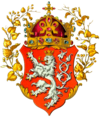Joanna of Bavaria
Joanna of Bavaria (1356 – 1386), a member of the House of Wittelsbach, was Queen of Germany from 1376 and Queen of Bohemia from 1378 until her death, by her marriage with the Luxembourg king Wenceslaus.[1]
Life
Presumably born in The Hague, Joanna was the second child of Duke Albert I of Bavaria (1336–1404), by his first wife Margaret (1342–1386), a daughter of the Piast duke Louis I of Brzeg. Her siblings included Count William VI of Holland, Johanna Sophia of Bavaria and Margaret of Bavaria. Her paternal grandparents were Emperor Louis IV and his consort Countess Margaret II of Hainaut.

From August 1370 Joanna travelled to Prague, where she was married on 29 September 1370 to Wenceslaus, son and heir of Emperor Charles IV by his third wife, Anna of Swidnica. The emperor had to obtain a papal dispense due to the close relatedness of the couple. The marriage was not consummated until 1376.
The conjugal bond suited the Luxembourg ruler to strengthen ties with the Bavarian duke, who held extensive estates in the Low Countries; nevertheless, Joanna was not the first choice of a bride for Wenceslaus. Charles IV had initially planned for him to marry the Hohenzollern princess Elisabeth of Nuremberg, but the marriage never took place, since Elisabeth married Rupert of the Palatinate instead.
Charles had his son elected King of the Romans in 1376 and upon his death in 1378, Wenceslaus also inherited the Kingdom of Bohemia. With Wenceslaus' accession, Joanna became Queen of both Bohemia and Germany. She also became Electress of Brandenburg as successor to Wenceslaus' half-sister Catherine.
Death
The marriage lasted for sixteen years, however the couple had no children (it is said that Wenceslaus was infertile due to his alcoholism). Joanna died in 1386 at the age of thirty or thirty-one,[2] allegedly from the consequences of an attack by Wenceslaus' hunting dogs.
Wenceslaus gave Johanna a magnificent funeral, which took place at Žebrák castle. According to custom, Joanna's body was exposed for a few days in Prague churches and was later buried in Prague Castle.
Wenceslaus later married Joanna's cousin, Sofia of Bavaria, but this marriage also bore no issue. Wenceslaus was deposed from the throne of Germany in 1400 and was succeeded by Elisabeth of Nuremberg's husband, Rupert.
Ancestors
| Ancestors of Joanna of Bavaria | ||||||||||||||||||||||||||||||||||||||||||||||||||||||||||||||||||||||||||||||||||||||||||||||||||||||||||||||||||||||||||||||||||||||||||||||||||||||||||||||||||||||||||||||||||||||||||||||||||||||||||||||||||||||||||||||||||||||||||||||||||||||||||||||||||||||||||||||||||||||||||||||||||||||||||||||||||||||||||||||||||||||||||||||||||||||||||||||||||||||||||||||||||||||||||||||||||||||||||||||||||||||||||||||||||||||||||||||||||||||||||||||||||||||||||||||||||||||||||||||||||||||||||||||||||||||||||||||||||||||||||||||||||||||||||||||||||||||||||||||||||||||||||||||||||||||||||||||||
|---|---|---|---|---|---|---|---|---|---|---|---|---|---|---|---|---|---|---|---|---|---|---|---|---|---|---|---|---|---|---|---|---|---|---|---|---|---|---|---|---|---|---|---|---|---|---|---|---|---|---|---|---|---|---|---|---|---|---|---|---|---|---|---|---|---|---|---|---|---|---|---|---|---|---|---|---|---|---|---|---|---|---|---|---|---|---|---|---|---|---|---|---|---|---|---|---|---|---|---|---|---|---|---|---|---|---|---|---|---|---|---|---|---|---|---|---|---|---|---|---|---|---|---|---|---|---|---|---|---|---|---|---|---|---|---|---|---|---|---|---|---|---|---|---|---|---|---|---|---|---|---|---|---|---|---|---|---|---|---|---|---|---|---|---|---|---|---|---|---|---|---|---|---|---|---|---|---|---|---|---|---|---|---|---|---|---|---|---|---|---|---|---|---|---|---|---|---|---|---|---|---|---|---|---|---|---|---|---|---|---|---|---|---|---|---|---|---|---|---|---|---|---|---|---|---|---|---|---|---|---|---|---|---|---|---|---|---|---|---|---|---|---|---|---|---|---|---|---|---|---|---|---|---|---|---|---|---|---|---|---|---|---|---|---|---|---|---|---|---|---|---|---|---|---|---|---|---|---|---|---|---|---|---|---|---|---|---|---|---|---|---|---|---|---|---|---|---|---|---|---|---|---|---|---|---|---|---|---|---|---|---|---|---|---|---|---|---|---|---|---|---|---|---|---|---|---|---|---|---|---|---|---|---|---|---|---|---|---|---|---|---|---|---|---|---|---|---|---|---|---|---|---|---|---|---|---|---|---|---|---|---|---|---|---|---|---|---|---|---|---|---|---|---|---|---|---|---|---|---|---|---|---|---|---|---|---|---|---|---|---|---|---|---|---|---|---|---|---|---|---|---|---|---|---|---|---|---|---|---|---|---|---|---|---|---|---|---|---|---|---|---|---|---|---|---|---|---|---|---|---|---|---|---|---|---|---|---|---|---|---|---|---|---|---|---|---|---|---|---|---|---|---|---|---|---|---|---|---|---|---|---|---|---|---|---|---|---|---|---|---|---|---|---|---|---|---|---|---|---|---|---|---|---|---|---|---|---|---|---|---|---|---|---|---|---|---|---|---|---|---|---|---|---|---|---|---|---|---|---|---|---|---|---|---|---|---|---|---|---|---|---|---|---|---|---|---|---|---|---|---|---|---|---|---|---|---|---|---|---|---|---|---|---|---|---|---|---|---|---|---|---|---|---|---|---|---|---|---|---|---|---|---|---|---|---|---|---|---|---|---|---|---|---|---|---|---|---|---|---|---|---|---|---|---|---|---|---|---|---|---|---|---|
| ||||||||||||||||||||||||||||||||||||||||||||||||||||||||||||||||||||||||||||||||||||||||||||||||||||||||||||||||||||||||||||||||||||||||||||||||||||||||||||||||||||||||||||||||||||||||||||||||||||||||||||||||||||||||||||||||||||||||||||||||||||||||||||||||||||||||||||||||||||||||||||||||||||||||||||||||||||||||||||||||||||||||||||||||||||||||||||||||||||||||||||||||||||||||||||||||||||||||||||||||||||||||||||||||||||||||||||||||||||||||||||||||||||||||||||||||||||||||||||||||||||||||||||||||||||||||||||||||||||||||||||||||||||||||||||||||||||||||||||||||||||||||||||||||||||||||||||||||
References and sources
- ^ N.Y.), Metropolitan Museum of Art (New York (2005). Prague: The Crown of Bohemia, 1347-1437. Metropolitan Museum of Art. ISBN 978-1-58839-161-2.
- ^ Czech Wikipedia
- ^ Suckale, Robert; Crossley, Paul (2005). Prague: The Crown of Bohemia, 1347-1437. Metropolitan Museum of Art. p. 16. ISBN 9781588391612. Retrieved 23 October 2018.
- Translated article from Czech Wikipedia
- Jeanne von Wittelsbach [permanent dead link]
| German royalty | ||
|---|---|---|
| Preceded by | Queen consort of Germany 1376 – 1386 | Vacant Title next held by Sofia of Bavaria |
| Queen consort of Bohemia 1378 – 1386 | ||
- v
- t
- e
Carolingian dynasty (843–911)
Kingdom of Germany (919–962)
Holy Roman Empire (962–1806)
- Adelaide of Italy
- Theophanu
- Cunigunde of Luxembourg
- Gisela of Swabia
- Gunhilda of Denmark
- Agnes of Poitou
- Bertha of Savoy
- Eupraxia of Kiev
- Constance of Sicily
- Matilda of England
- Richenza of Northeim
- Gertrude of Comburg
- Gertrude of Sulzbach
- Adelaide of Vohburg
- Beatrice I, Countess of Burgundy
- Constance, Queen of Sicily
- Irene Angelina
- Beatrice of Swabia
- Constance of Aragon
- Margaret of Austria
- Isabella II of Jerusalem
- Isabella of England
- Bianca Lancia
- Elisabeth of Bavaria
- Gertrude of Hohenberg
- Isabella of Burgundy
- Imagina of Isenburg-Limburg
- Elisabeth of Carinthia
- Margaret of Brabant
- Beatrice of Silesia
- Isabella of Aragon
- Margaret II, Countess of Hainaut
- Blanche of Valois
- Anne of Bavaria
- Anna von Schweidnitz
- Elizabeth of Pomerania
- Joanna of Bavaria
- Sophia of Bavaria
- Elisabeth of Nuremberg
- Barbara of Cilli
- Elizabeth of Luxembourg
- Eleanor of Portugal
- Bianca Maria Sforza
- Isabella of Portugal
- Anne of Bohemia and Hungary
- Maria of Austria
- Anna of Tyrol
- Eleonora Gonzaga
- Maria Anna of Spain
- Maria Leopoldine of Austria
- Eleonora Gonzaga
- Margaret Theresa of Spain
- Claudia Felicitas of Austria
- Eleonore Magdalene of Neuburg
- Wilhelmine Amalie of Brunswick
- Elisabeth Christine of Brunswick-Wolfenbüttel
- Maria Amalia
- Maria Theresa
- Maria Josepha of Bavaria
- Maria Luisa of Spain
- Maria Theresa of Naples and Sicily















